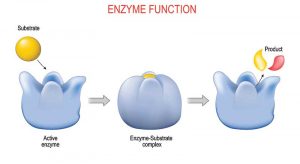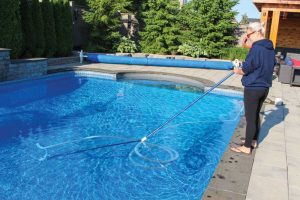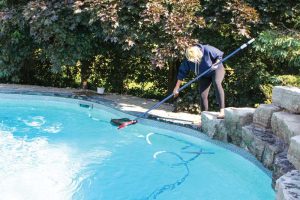
Proteins, starches, oils, and greases from bather waste are often harder for chlorine to break down. Chlorine alone can break down most of these waste products through oxidation; however, it is also consumed in those reactions and, therefore, becomes less effective at killing bacteria. Using supplemental compounds with enzymes reduces this burden on chlorine, allowing it to focus more on getting rid of harmful bacteria and nitrogenous compounds.
How are enzymes selected?
Choosing the right enzyme package in new product development is an important and complex process for performance optimization. Enzymes chosen for the product should be based on the environment to which it will be introduced to, and the organic materials intended for removal. They can be naturally occurring through controlled biological processes, or they can be synthetically produced as well. Regardless of how they are made, enzymes are highly selective and only target specific structures. This specificity is a result of the relationship between the shape of the target, the substrate, and the active site where the “target” latches onto for the reaction to occur. Active sites are shaped specifically for unique substrates to merge with, much like puzzle pieces.

Pool products offering broad ranges of enzymes are more effective than just one or two types of enzymes. Naturally, wastes dwelling in pools might differ from those in spas. In pools, the enzymes selected should treat a variety of waste coming from biological or environmental sources. Amylases break down starches released during the degradation of algae or leaf debris, while proteases can help breakdown waste left behind from animals or swimmers. The same package used in swimming pools could be ineffective if used in spas. With spas, much of the waste matter comes from biological sources. Enzymes, such as lipase or mannanase, target fatty and oily residues left behind in spas from lotions, hair products, or body oils amplified by the warmer water temperature. The enzyme packages used in commercial pools and spas would also differ from products used in recreational pools. Commercial pool operators adopt automatic feeders to constantly supply metered doses of enzymes. This supplementation can help avoid inconvenient downtime of the pool, often accompanied by high chlorine residuals following a remediation treatment.
What affects enzymatic activity?
Enzyme functionality can be affected by many conditions, many of which occur routinely in pool water. Temperature can be a major factor with enzymatic activity. In laundry, enzymes in detergents are often selected to remove specific types of stains using the more energy-efficient colder water temperatures. Spa water is much warmer and requires more heat-tolerant enzymes since high heat denatures most enzyme activity. In most enzyme pool and spa products, the broad selection of enzymes is buffered to prevent denaturation due to temperature and pH imbalance. High sanitizer residuals also hinder enzyme functionality, which is why traditional chlorine and salt users should verify whether the free chlorine (FC) is below five parts per million (ppm) before adding a certain enzyme-based product. It is always important to read and follow label directions to maximize product effectiveness.
Getting more out of filters by using enzymes

Filter upkeep is exceptionally important in maintaining a healthy pool. As contaminants interact with enzymes, the products of the reactions are often trapped and removed by the pool’s filtration system. Dirt and debris trap themselves in oils and greases and eventually form layers in the filter, resulting in tedious clogs which must be physically removed to allow adequate filtration cycles. The use of enzyme-based products are often overlooked. Since enzymes function even after attacking one target, they can move on to the next one, which includes working inside the filter. Regular use of enzymes in the filter can prevent contaminants from building up, which will allow for less cartridge cleaning or sand backwashing.

Cleaners with enzymes and surfactants
Enzymatic cleaners typically contain a mixture of enzymes and surfactants. When combined in the same formula, these products are highly effective in reducing and treating organic accumulations. Enzyme-based pool and spa products use enzymes commonly buffered with surfactants to break down the organic material accumulating along the waterline, in the skimmer, and on the filters of most pools and spas to reduce physical maintenance.






